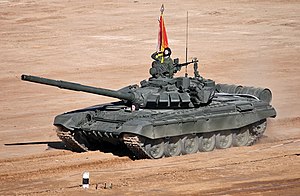T-72
| T-72 | |
|---|---|

T-72B3
|
|
| Type | Main battle tank |
| Place of origin | Soviet Union |
| Service history | |
| In service | 1973–present |
| Used by | See Operators |
| Wars | See Combat History |
| Production history | |
| Designer | Leonid Kartsev-Valeri Venediktov |
| Designed | 1967–1973 |
| Manufacturer | Uralvagonzavod |
| Unit cost | 0.5-1.2 in 1994-1996, 30,962,000–61,924,000 rubles (US$1–2 million) (in 2009) |
| Produced | 1973–present |
| Number built | 25,000+ |
| Specifications (T-72A) | |
| Weight | 41.5 tonnes (45.7 short tons), 44.5 tonnes (49.1 short tons) (T-72B) |
| Length | 9.53 m (31 ft 3 in) gun forward 6.95 m (22 ft 10 in) hull |
| Width | 3.59 m (11 ft 9 in) |
| Height | 2.23 m (7 ft 4 in) |
| Crew | 3 |
|
|
|
| Armour | steel and composite armour |
|
Main
armament |
125 mm 2A46M/2A46M-5 smoothbore gun |
|
Secondary
armament |
|
| Engine | V-12 diesel V-92S2F (T-72B3 & T-72B3M) 780 hp (582 kw) 1130 hp (831 kW) for V-92S2F |
| Power/weight | 18.8 hp (14 kW) / tonne |
| Transmission | Synchromesh, hydraulically assisted, with 7 forward and 1 reverse gears. |
| Suspension | Torsion bar |
| Ground clearance | 0.49 m (19 in) |
| Fuel capacity | 1,200 L (320 U.S. gal; 260 imp gal) |
|
Operational
range |
460 km (290 mi), 700 km (430 mi) with fuel drums |
| Speed | 60 km/h (37 mph) |
|
|
|
|
|
The T-72 is a Soviet second-generation main battle tank that entered production in 1971. About 20,000 T-72 tanks were built, making it one of the most widely produced post–World War II tanks, second only to the T-54/55 family. The T-72 was widely exported and saw service in 40 countries and in numerous conflicts. Improved variants are still being built for export customers.
The development of the T-72 was a direct result of the introduction of the T-64 tank. The T-64 (Object 432) was a very ambitious project to build a competitive tank with a weight of not more than 36 tons under the direction of Alexander Morozov in Kharkov. To achieve that goal, the crew was reduced to three soldiers, saving the loader by introducing an automated loading system. This and other steps allowed a reduced weight, but caused problems when looking for a reliable engine to fit in the smaller hull.
The production of the T-64 with a 115-mm gun began in 1964, but plans to build the T-64A with a more powerful 125-mm gun had already been made back in 1963.
Problems with the first batch of T-64 tanks were centred on the 5TDF 700 hp engine and the auto loading mechanism. The engine was unreliable, was difficult to repair and had a guaranteed life span of only a World War 2-era tank engine.
A strong lobby around designer Morozov advocated for the T-64 in Moscow, preventing rival developments and ideas to be discussed.
A mobilization model of the T-64 with the cheaper and much more reliable V-45 engine (780 hp) was to be developed by Uralvagonzavod, since the Malyshev Factory in Kharkov could not provide a sufficient number of 5TDF engines for all Soviet tank factories in wartime.
The 5TDF was too complex and its production twice as costly as the V-45 engine. In 1967, the Uralvagonzavod formed "Section 520", which was to prepare the serial production of the T-64 for 1970. The team soon found out that the more powerful V-45 engine put a lot of stress on the fragile T-64 hull, so that after some time cracks started to materialize. A more stable solution had to be found.
Finally, an idea from 1960 was used, when a modification of the T-62 had been discussed: In 1961, two prototypes of "Object 167" had been built by Uralvagonzavod to test a more powerful hull and running gear combination for that tank. Under influence from Kharkov, the idea had been turned down by Moscow. But this construction, with its big, rubbercoated roadwheels now formed the basis for the "mobilisation model" of the T-64.
...
Wikipedia
